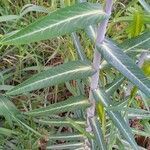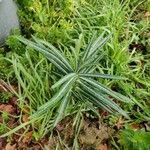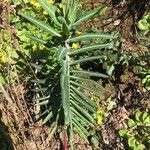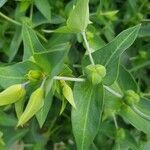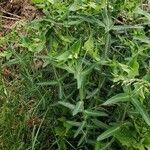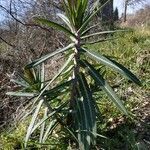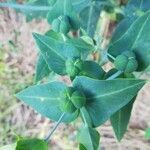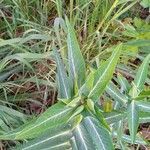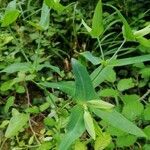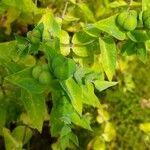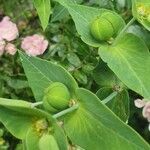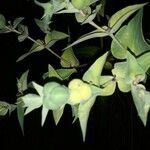Herbs, annual or biennial, with taproot. Stems erect, unbranched or branched, 200 cm, glabrous, glaucous. Leaves opposite, decussate; petiole absent; blade linear to oblong-lanceolate, 30–120 × 3–25 mm, base acute, rounded, cordate or clasping, margins entire, apex acute or subobtuse, sometimes mucronate, surfaces glabrous, abaxial ± glaucous; venation pinnate, midvein prominent. Cyathial arrangement: terminal pleiochasial branches 2–4, each 1–2 times 2-branched; pleiochasial bracts cordate-lanceolate, shorter and wider than distal leaves; dichasial bracts distinct, ovate-oblong to lanceolate, base subcordate, margins entire, apex acute; axillary cymose branches 0–10. Cyathia: peduncle 0–0.5 mm. Involucre campanulate, 1.2–2.3 × 1.4–2.5 mm, glabrous; glands 4, elliptic, 0.3–0.6 × 1–1.3 mm; horns divergent, thick, tips rounded, dilated, 0.5–1.4 mm. Staminate flowers 25–30. Pistillate flowers: ovary glabrous; styles 0.7–2.2 mm, 2-fid. Capsules depressed-globose, 9–12 × 12–16 mm, deeply 3-lobed, tardily dehiscent and appearing indehiscent, mesocarp spongy; cocci rounded, smooth, glabrous; columella 4–5.2 mm. Seeds brownish or blackish, oblong, 4.5–6 × 3–4.2 mm, rugose, irregularly reticulate; caruncle substipitate, hat-shaped, 1.6–2 × 1.2–1.5 mm.
Glabrous, erect annual to biennial. Stems c. 30-120 cm high, usually not branched at base. Lvs opposite, decussate, exstipulate, sessile, entire, linear to oblong-lanceolate, truncate, acute and often mucronate at apex, 30-150 mm long, glaucous especially when young. Terminal umbel usually 3-4-rayed, with sometimes numerous axillary branches below; lvs subtending rays similar to stem lvs but slightly broader toward base; rays often secondarily branched and then usually forming compound dichasia or developed pseudomonopodially; lvs subtending ray-branches and cyathia broadly triangular, cordate at base. Glands crescent-shaped; horns blunt. Capsule ± smooth or slightly rugose, shallowly grooved, grooved on keels. Seeds rugulose, rounded, brown or grey, c. 5 mm long.
Annual or biennial, glabrous and glaucous, to 1 or even 2 m, usually simple to the umbel; cauline lvs opposite, linear or lance-linear, sessile at the truncate or subcordate base, those subtending the umbel similar, usually 4, those of the umbel lance-ovate to deltoid-ovate; involucres 4 mm; fr 1 cm, thick-walled, tardily dehiscent; seeds 4–6 mm, very plump, wrinkled and carunculate; 2n=20. Native of the Mediterranean region, escaped from cult. here and there in our range. May–Sept. (Tithymalus l.; Galarhoeus l.)
A herb or shrub. It has a stout erect stem. The leaves are almost opposite. They are dark bluish green and do not have a leaf stalk. The leaf surface is paler underneath. The sap can irritate the skin and is possibly poisonous. The fruit look like capers (Capparis spinosa).
